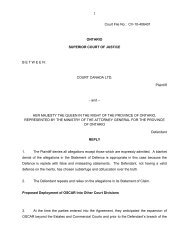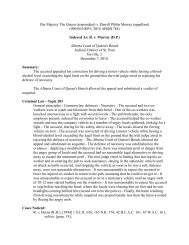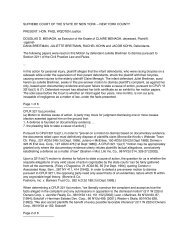Rogers Communications Inc., Rogers Wireless Partnership ... - Slaw
Rogers Communications Inc., Rogers Wireless Partnership ... - Slaw
Rogers Communications Inc., Rogers Wireless Partnership ... - Slaw
Create successful ePaper yourself
Turn your PDF publications into a flip-book with our unique Google optimized e-Paper software.
was argued, based on American jurisprudence and in particular, Carton Network v. CSCHoldings <strong>Inc</strong>., that the potential audience of "each point-to-point transmission" had to beconsidered to determine whether a given transmission was "to the public" - The SupremeCourt held that this case was of no assistance in interpreting the phrase "communicate awork to the public" because of the difference in wording between the American andCanadian legislation - The court stated that "This Court has recognized in the pastimportant differences both in wording and in policy between Canadian and Americancopyright legislation. It has warned that 'United States court decisions, even where thefactual situations are similar, must be scrutinized very carefully' ..." - See paragraphs 50and 51.Copyright - Topic 3436Fees, charges or royalties - Determination of - Communication to the public bytelecommunication - The Supreme Court of Canada stated that "Ultimately, indetermining the extent of copyright, regard must be had for the fact that '[t]he CopyrightAct is usually presented as a balance between promoting the public interest in theencouragement and dissemination of works of the arts and intellect and obtaining a justreward for the creator' (Théberge v. Galerie d'Art du Petit Champlain inc., 2002 SCC34 ... This balance is not appropriately struck where the existence of copyright protectiondepends merely on the business model that the alleged infringer chooses to adopt ratherthan the underlying communication activity. Whether a business chooses to conveycopyright protected content in a traditional, 'broadcasting' type fashion, or opts for newerapproaches based on consumer choice and convenience, the end result is the same. Thecopyrighted work has been made available to an aggregation of individuals of the generalpublic" - See paragraph 40.Copyright - Topic 3436Fees, charges or royalties - Determination of - Communication to the public bytelecommunication - At issue was whether the streaming of files (musical works) fromthe Internet triggered by individual users constituted communication “to the public” ofthe musical works by online music services (appellants) who made the files available tothe users for streaming (Copyright Act, s. 3(1)(f)) - The Supreme Court of Canada statedthat "... the appellants proposed rule that each transmission should be analyzed inisolation because each was initiated at the request of individual members of the publicwould have the effect of excluding all interactive communications from the scope of thecopyright holder’s exclusive rights to communicate to the public and to authorize suchcommunications. A stream is often effectuated at the request of the recipient. On-demandtelevision allows viewers to request and view the desired program at the time of theirchoosing. By definition, on-demand communications — relating to the so-called 'pull'technologies — are initiated at the request of the user, independently of any other user,and each individual transmission happens in a point-to-point manner. None of thesetelecommunications would be considered as being made 'to the public' simply becausethe actual transmission occurs at the initiative and discretion of the consumer to acceptthe invitation to the public to access the content. Nothing in the wording of s. 3(1)(f) ofthe [Copyright] Act implies such a limitation. A communication is not restricted to apurely non-interactive context" - See paragraphs 34 and 35.


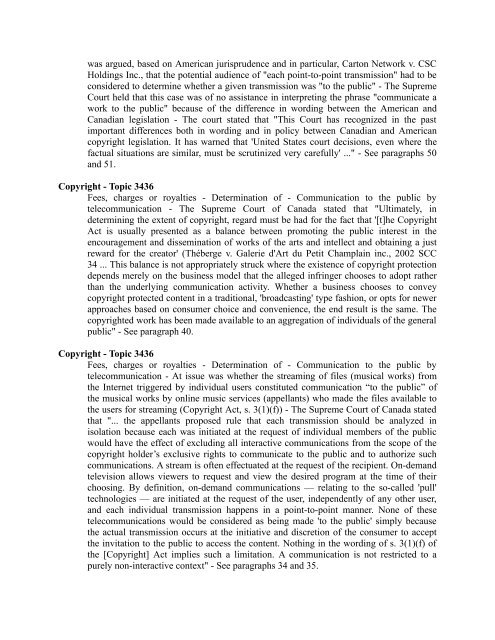
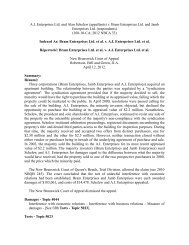
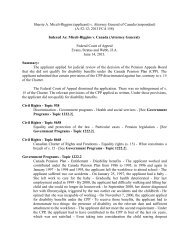
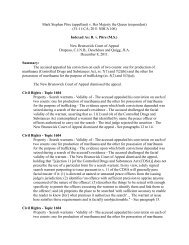
![Jones (appellant) v. Kaney (respondent) ([2011] UKSC 13 ... - Slaw](https://img.yumpu.com/46577625/1/190x245/jones-appellant-v-kaney-respondent-2011-uksc-13-slaw.jpg?quality=85)
